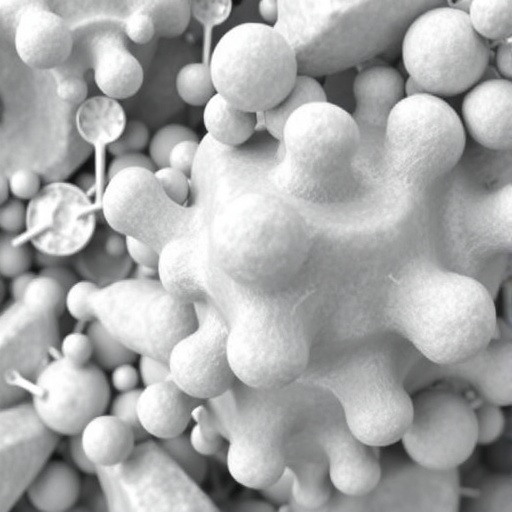In a groundbreaking study, researchers Liu et al. delve deep into the synthesis and electrochemical performance of a mixed phosphate material, Na₃Fe₂PO₄₂O₇, a compound that holds promise for sodium storage applications. As the demand for efficient energy storage solutions continues to skyrocket, the significance of exploring alternative materials and their properties becomes imperative. This work contributes to the ongoing quest in material science, aimed at discovering innovative compounds that can effectively deliver better performance in energy storage technologies, particularly in the context of sodium-ion batteries.
The study’s authors embark on a meticulous journey to synthesize Na₃Fe₂PO₄₂O₇ using a solid-state reaction method. This technique is renowned for its ability to yield materials with high purity and favorable structural properties, which are vital for their electrochemical applications. The synthesis parameters, such as temperature and reaction time, are fine-tuned to optimize the material’s crystalline structure, ensuring enhanced performance during sodium ion intercalation and deintercalation processes.
The characterization of the synthesized material is comprehensive, involving a range of techniques crucial for confirming the structural and electrochemical attributes of Na₃Fe₂PO₄₂O₇. X-ray diffraction (XRD) analysis reveals valuable information about the crystallinity and phase purity of the material, indicating its suitability for practical applications. Additionally, scanning electron microscopy (SEM) provides insights into the morphology of the particles, highlighting their uniform size and shape, which are instrumental in facilitating effective ionic transport.
Electrochemical characterization forms the core of the research, wherein the performance of Na₃Fe₂PO₄₂O₇ is rigorously evaluated. Cyclic voltammetry (CV) tests demonstrate a well-defined redox behavior, crucial for the cycling stability of sodium storage materials. These results underscore the material’s potential in maintaining efficient charge and discharge cycles, a critical aspect for any battery application. The investigation also employs galvanostatic charge-discharge tests, revealing impressive capacity retention over numerous cycles, which is vital for assessing the longevity and reliability of sodium-ion batteries.
As the researchers explore the mechanisms underlying sodium storage in this novel compound, they cite the significance of the material’s layered structure. This arrangement facilitates the diffusion of sodium ions, promoting high-rate capabilities. The understanding of ion migration pathways and charge transfer kinetics provides a robust framework for developing more efficient energy storage systems. Moreover, this fundamental insight into the material properties paves the way for future investigations on improving electrochemical performance through compositional modifications.
The implications of this research extend beyond the immediate results, as the authors discuss the environmental and economic advantages of adopting sodium-rich materials in energy storage technologies. Sodium is abundant and widely available, making it an attractive alternative to lithium-ion systems, which are limited by resource constraints. By highlighting these benefits, the study appeals to a broader audience, including policymakers and industry players looking to transition to sustainable energy solutions.
Advancements in material science, particularly in the realm of sodium storage, are critical as the global community faces mounting pressures to enhance energy efficiency and reduce carbon footprints. The findings from Liu et al.’s work contribute not only to the scientific dialogue but also align with global sustainability goals by promoting the utilization of more sustainable materials in battery production. The study serves as a clarion call for further exploration into alternative compounds that can meet the demands of modern energy systems.
In a world increasingly reliant on energy storage technologies, the shift towards sodium-ion batteries could significantly reshape the market. By addressing safety concerns and resource limitations associated with lithium-ion batteries, innovations like Na₃Fe₂PO₄₂O₇ could lead to more resilient and versatile energy solutions. The attention to sodium storage technologies could inspire a new generation of researchers and entrepreneurs to explore untapped potential within alternative materials, ultimately leading to a diversified and robust energy landscape.
The authors conclude the article with a call to arms for the scientific community to invest in further research on sodium-based materials, arguing that the progress made in this study is just the tip of the iceberg. Future studies could examine various dopants and structural modifications that may further enhance the electrochemical performance of sodium phosphate compounds. Additionally, scaling up the synthesis processes for industrial applications could hasten the transition to more sustainable energy storage systems.
In summary, Liu et al.’s study on Na₃Fe₂PO₄₂O₇ represents a significant advance in the field of sodium storage technology. By systematically synthesizing and characterizing this novel compound, the researchers contribute valuable insights that could lead to practical applications in energy storage. As the need for sustainable energy solutions grows, the findings from this research offer a promising outlook for the future of sodium-ion batteries and underscore the importance of continued innovation in materials science.
Through meticulous research and exploration, Liu et al. provide a new direction for energy storage technologies, advocating for a more sustainable approach that balances performance with environmental responsibility. As society stands on the brink of an energy revolution, studies like this illuminate pathways that could lead to a more efficient and sustainable future.
Subject of Research: Synthesis and electrochemical performance of mixed phosphate material Na₃Fe₂PO₄₂O₇.
Article Title: Synthesis and electrochemical sodium storage performance of mixed phosphate material Na₃Fe₂PO₄₂O₇.
Article References:
Liu, G., Chen, L., Liu, Z. et al. Synthesis and electrochemical sodium storage performance of mixed phosphate material Na3Fe2PO4P2O7.
Ionics (2025). https://doi.org/10.1007/s11581-025-06740-0
Image Credits: AI Generated
DOI: https://doi.org/10.1007/s11581-025-06740-0
Keywords: Sodium-ion batteries, electrochemistry, energy storage, mixed phosphate materials, sustainability.
Tags: alternative energy materialscrystallinity and phase purity in materialselectrochemical performance of phosphateshigh purity synthesis techniquesinnovative energy storage solutionsmaterial characterization techniquesNa3Fe2PO4P2O7 synthesisscanning electron microscopy applicationssodium storage technologysodium-ion batteries researchsolid-state reaction methodX-ray diffraction analysis





